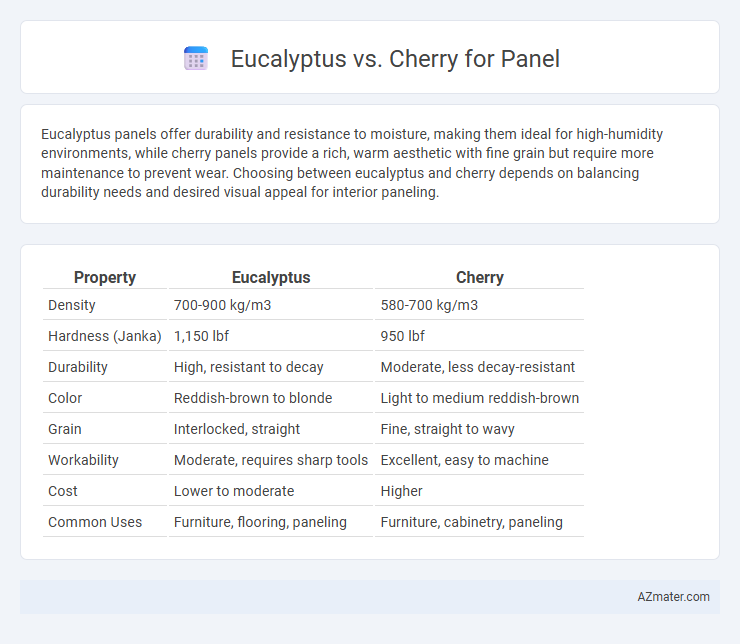Eucalyptus panels offer durability and resistance to moisture, making them ideal for high-humidity environments, while cherry panels provide a rich, warm aesthetic with fine grain but require more maintenance to prevent wear. Choosing between eucalyptus and cherry depends on balancing durability needs and desired visual appeal for interior paneling.
Table of Comparison
| Property | Eucalyptus | Cherry |
|---|---|---|
| Density | 700-900 kg/m3 | 580-700 kg/m3 |
| Hardness (Janka) | 1,150 lbf | 950 lbf |
| Durability | High, resistant to decay | Moderate, less decay-resistant |
| Color | Reddish-brown to blonde | Light to medium reddish-brown |
| Grain | Interlocked, straight | Fine, straight to wavy |
| Workability | Moderate, requires sharp tools | Excellent, easy to machine |
| Cost | Lower to moderate | Higher |
| Common Uses | Furniture, flooring, paneling | Furniture, cabinetry, paneling |
Introduction to Eucalyptus and Cherry Wood Panels
Eucalyptus wood panels are known for their durability, resistance to moisture, and attractive grain patterns, making them ideal for furniture and interior applications. Cherry wood panels offer a rich reddish-brown hue, smooth texture, and excellent workability, commonly used for high-end cabinetry and decorative finishes. Both woods provide distinct aesthetic and functional benefits, with eucalyptus emphasizing sustainability and hardness, while cherry is prized for its elegance and aging beauty.
Botanical Origins and Growth Patterns
Eucalyptus, belonging to the Myrtaceae family, is a fast-growing evergreen tree native to Australia, known for its tall stature and straight trunk ideal for panel production. Cherry, from the genus Prunus in the Rosaceae family, grows slower as a deciduous hardwood native to the Northern Hemisphere, prized for its rich color and fine grain in furniture panels. The rapid growth of Eucalyptus allows for quicker harvest cycles, while Cherry's slower development contributes to its dense, durable wood valued in high-end applications.
Appearance and Color Variations
Eucalyptus panels showcase a warm, creamy base with subtle reddish-brown streaks, offering a dynamic range of smooth and wavy grain patterns that brighten interior spaces. Cherry panels present a rich reddish-brown hue that deepens and darkens over time, paired with a fine, straight grain that exudes classic elegance. The natural color variations in eucalyptus tend to be more pronounced and varied, while cherry maintains a more uniform but deepening tone, making each ideal for different aesthetic preferences in paneling.
Durability and Hardness Comparison
Eucalyptus wood demonstrates higher durability and resistance to wear due to its dense fiber structure, making it ideal for heavy-use panels. Cherry wood offers moderate hardness with a Janka rating around 950, providing smooth sanding and aesthetic appeal but lower impact resistance. For applications requiring superior durability and hardness, eucalyptus panels outperform cherry in longevity and toughness.
Workability and Machining Properties
Eucalyptus panels exhibit excellent workability with moderate hardness, allowing smooth cutting and shaping, while cherry wood offers superior machinability due to its fine, even texture and natural oils that reduce tool wear. Eucalyptus may require sharper blades to prevent tear-out during machining, whereas cherry wood machines cleanly with minimal effort, producing smooth edges and surfaces. Both woods respond well to sanding and finishing, but cherry's consistent grain enhances the ease of achieving a high-quality surface-ready panel.
Environmental Impact and Sustainability
Eucalyptus panels offer rapid growth and high carbon sequestration, making them a more sustainable choice compared to cherry wood, which grows slower and requires longer harvesting cycles. Eucalyptus plantations can be managed sustainably with shorter rotation periods and efficient land use, reducing deforestation risks associated with cherry harvesting. While cherry wood provides high aesthetic value, eucalyptus panels typically have a lower environmental footprint due to their renewability and lower biodiversity impact.
Price and Availability Factors
Eucalyptus panels generally offer a more cost-effective solution due to the wood's faster growth rate and widespread availability in many regions. Cherry panels tend to be more expensive, driven by their slower growth and limited availability, especially in high-quality grades. The consistent supply and competitive pricing of eucalyptus make it a preferred choice for budget-conscious projects.
Common Applications in Paneling
Eucalyptus and cherry wood are widely used in paneling, each offering unique benefits for interior design. Eucalyptus panels are favored for their durability and resistance to moisture, making them ideal for high-traffic areas and damp environments such as kitchens and bathrooms. Cherry wood panels provide a rich, warm aesthetic with fine grain patterns, commonly used in upscale residential and commercial settings to create elegant, polished wall treatments.
Maintenance and Longevity
Eucalyptus panels exhibit high durability with natural resistance to decay and insects, requiring minimal maintenance such as periodic sealing to preserve their lifespan of up to 25 years. Cherry wood panels, while aesthetically rich and stable, demand more frequent care, including moisture control and refinishing, to prevent surface wear and prolong usability around 20 years. Choosing eucalyptus offers a lower-maintenance, longer-lasting solution ideal for high-traffic areas, whereas cherry requires attentive upkeep to maintain its premium appearance.
Choosing the Right Wood for Your Panels
Eucalyptus panels offer durability and a distinctive, warm reddish hue, making them ideal for both interior and exterior applications where moisture resistance is key. Cherry wood provides a smooth texture and rich, deep color that ages beautifully, enhancing luxury spaces with elegance and warmth. Selecting the right wood depends on the desired aesthetic, environmental conditions, and maintenance needs, with eucalyptus excelling in toughness and cherry favored for premium finishes.

Infographic: Eucalyptus vs Cherry for Panel
 azmater.com
azmater.com